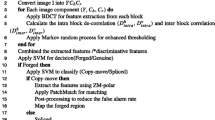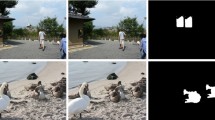Abstract
Splicing and copy-paste are popular means of blind digital image manipulation. In this article, a novel identification of composite splicing and copy-paste manipulation is achieved concurrently on the forgery detection standard datasets Extended IMD2020, CASIA v1.0, and CASIA v2.0. An image under supervision is taken first, and texture-based Orientation Invariant Local Binary Pattern (OILBP) features are extricated using the Discrete Cosine Transform. The proposed technique uses an SVM classifier to decide whether the input image is spliced. Also, the proposed algorithm can check for copy-paste forgery in the image when not spliced. For copy-paste detection, Accelerated-KAZE (AKAZE) features are used to locate the replicated regions in the image. There is a copy-move forgery in the image to be discovered when the features match after post-processing filtering. Otherwise, the image is authentic. Experimental results illustrate that the performance of the proposed approach is improved than previous works. One of the significant advantages is that two types of forgeries can be detected simultaneously using the proposed cohesive approach.





Similar content being viewed by others
Data availability
Data sharing not applicable to this article as no datasets were generated or analyzed during the current study.
References
Haouzia A, Noumeir R (2008) Methods for image authentication : a survey. Multimed Tools Appl 39(1):1–46. https://doi.org/10.1007/s11042-007-0154-3
Kaur M, Gupta S (2015) Evaluation of image forensic cues for fusion. In: 2015 Third International Conference on Image Information Processing Evaluation, pp 301–305
Walia S, Kumar K (2019) Digital image forgery detection: a systematic scrutiny. Australian J Forensic Sci 51(5):488–526. https://doi.org/10.1080/00450618.2018.1424241
Zhang Z, Zhou Y (2008) Study of image splicing detection. Adv Intell Comput Theor Appl Aspects Theor Methodol Issues 5226:1103–1110
Fridrich J, Soukal D, Lukas J (2003) Detection of copy-move forgery in digital images. In: Digital Forensic Research Workshop, pp 55–61
Bakiah N et al (2016) Copy-move forgery detection: Survey, challenges and future directions. J Netw Comput Appl 75:259–278
Christlein V, Riess C, Jordan J, Riess C, Angelopoulou E (2012) An evaluation of popular copy-move forgery detection approaches. IEEE Trans Inf Forensics Secur 7(6):1841–1854
Li G, Wu Q, Tu D, Sun S (2007) A sorted neighborhood approach for detecting duplicated regions in image forgeries based on DWT and SVD. In: IEEE International Conference on Multimedia and Expo, pp 1750–1753. https://doi.org/10.1109/ICME.2007.4285009
Ng TT, Chang SF (2004) A model for image splicing. In: International Conference on Image Processing (ICIP), pp 1169–1172
Pun C, Liu B, Yuan X (2016) Multi-scale noise estimation for image splicing forgery detection. J Vis Commun Image Represent 38:195–206
Kaur M, Walia S (2016) Forgery detection using noise estimation and HOG feature extraction. Int J Multimed Ubiquitous Eng 11(4):37–48. https://doi.org/10.14257/ijmue.2016.11.4.05
Lin Z, Wang R, Tang X, Shum H-Y (2005) Detecting doctored images using camera response normality and consistency. In: IEEE Computer Society Conference on Computer Vision and Pattern Recognition (CVPR’05), pp 1087–1092. https://doi.org/10.1109/CVPR.2005.125
Alahmadi A, Hussain M, Aboalsamh H, Muhammad G, Bebis G, Mathkour H (2017) Passive detection of image forgery using DCT and local binary pattern. Signal Image Video Process 11(1):81–88. https://doi.org/10.1007/s11760-016-0899-0
Lin X, Wang S-L, Huang W-J, Liew AW-C, Huang X-S, Wu J (2019) Toward adaptive BDCT feature representation based image splicing measurement in smart cities. Measurement 139:61–69. https://doi.org/10.1016/j.measurement.2019.02.086
Hussain M, Saleh SQ, Aboalsamh H, Muhammad G, Bebis G (2014) Comparison between WLD and LBP descriptors for non-intrusive image forgery detection. In: International Symposium on Innovations in Intelligent Systems and Applications (INISTA), pp 197–204. https://doi.org/10.1109/INISTA.2014.6873618
Hussain M, Qasem S, Bebis G, Muhammad G, Aboalsamh H, Mathkour H (2015) Evaluation of image Forgery Detection using Multi-scale Weber local descriptors. Int J Artif Intell Tools 24(4):416–424. https://doi.org/10.1142/s0218213015400163
El-alfy EM, Qureshi MA (2015) Combining spatial and DCT based Markov features for enhanced blind detection of image splicing. Pattern Anal Appl 18:713–723. https://doi.org/10.1007/s10044-014-0396-4
Zhao X, Wang S, Li S, Li J (2015) Passive image splicing detection by a 2-D Noncausal Markov Model. IEEE Trans Circuits Syst Video Technol 25(2):185–199
Vidyadharan DS, Thampi SM (2017) Digital image forgery detection using compact multi-texture representation. J Intell Fuzzy Syst 32(4):3177–3188. https://doi.org/10.3233/JIFS-169261
Rajab A, Mohd A, Mohd S, bin Sulong G (2019) Splicing image forgery identification based on artificial neural network approach and texture features. Cluster Comput 22:647–660. https://doi.org/10.1007/s10586-017-1668-8
Agarwal S, Chand S (2015) Image forgery detection using multi scale entropy filter and local phase quantization. Int J Image Graphics Signal Process 10:78–85. https://doi.org/10.5815/ijigsp.2015.10.08
Kaur M, Gupta S (2016) A passive blind approach for image splicing detection based on DWT and LBP Histograms. In: International Symposium on Security in Computing and Communication, pp 318–327. https://doi.org/10.1007/978-981-10-2738-3
Han JG, Park TH, Moon YH, Eom IK (2016) Efficient Markov feature extraction method for image splicing detection using maximization and threshold expansion. J Electron Imaging 25(2):1–8. https://doi.org/10.1117/1.JEI.25.2.023031
He Z, Lu W, Sun W, Huang J (2012) Digital image splicing detection based on Markov features in DCT and DWT domain. Pattern Recognit 45:4292–4299
Walia S, Kumar K, Kumar M, Gao XZ (2021) Fusion of handcrafted and deep features for forgery detection in digital images. IEEE Access 9:99742–99755. https://doi.org/10.1109/ACCESS.2021.3096240
Zhao D, Tian X (2022) A multiscale fusion lightweight image-splicing tamper-detection model. Electronics (Switzerland) 11(16):1–14. https://doi.org/10.3390/electronics11162621
Cozzolino D, Poggi G, Verdoliva L (2014) Copy-move forgery detection based on Patchmatch. In: 2014 IEEE International Conference on Image Processing (ICIP). IEEE, Paris, France, pp 5312–5316. https://doi.org/10.1109/ICIP.2014.7026075
Deng J, Yang J, Weng S, Gu G, Li Z (2018) Copy-move forgery detection robust to various transformation and degradation attacks. KSII Trans Internet Inf Syst 12(9):4467–4486. https://doi.org/10.3837/tiis.2018.09.019
Mahmood T, Irtaza A, Mehmood Z, Mahmood TM (2017) Copy–move forgery detection through stationary wavelets and local binary pattern variance for forensic analysis in digital images. Forensic Sci Int 279:8–21. https://doi.org/10.1016/j.forsciint.2017.07.037
Fadl SM, Semary NA (2017) Robust Copy–Move forgery revealing in digital images using polar coordinate system. Neurocomputing 265:57–65. https://doi.org/10.1016/j.neucom.2016.11.091
Kumar S, Gupta SK, Kaur M, Gupta U (2022) VI-NET: a hybrid deep convolutional neural network using VGG and inception V3 model for copy-move forgery classification. J Vis Commun Image Represent 89:103644. https://doi.org/10.1016/j.jvcir.2022.103644
Lowe DG (2004) Distinctive image features from Scale-Invariant keypoints. Int J Comput Vision 60(2):91–110. https://doi.org/10.1023/B:VISI.0000029664.99615.94
Bay H, Ess A, Tuytelaars T, van Gool L (2008) Speeded-Up Robust Features (SURF). Comput Vis Image Underst 110:346–359. https://doi.org/10.1016/j.cviu.2007.09.014
Alcantarilla PF, Bartoli A, Davison AJ (2012) “KAZE Features”, in Computer Vision – ECCV 2012. Lect Notes Comput Sci 7577:214–227
Wang S, You H, Fu K (2012) A novel method to find feature matches for SAR image registration. IEEE Geosci Remote Sens Lett 9(4):649–653. https://doi.org/10.1109/LGRS.2011.2177437
Dong J, Wang W, Tan T (2013) CASIA image tampering detection evaluation database (CAISA TIDE). In: IEEE China Summit and International Conference on Signal and Information Processing. IEEE, pp 422–426. http://forensics.idealtest.org. Accessed 3 Nov 2022
Novozámský A, Mahdian B, Saic S (2021) Extended IMD2020: a large-scale annotated dataset tailored for detecting manipulated images. IET Biom 10(4):392–407. https://doi.org/10.1049/bme2.12025
Kanwal N, Girdhar A, Kaur L, Bhullar JS (2019) Detection of dgital image forgery using fast fourier transform and local features. In: International Conference on Automation, Computational and Technology Management (ICACTM), pp 262–267
Wang R et al (2018) Digital image splicing detection based on Markov features in QDCT and QWT domain. Int J Digit Crime Forensics 10(4):90–107. https://doi.org/10.4018/IJDCF.2018100107
Wang J, Liu R, Wang H, Wu B, Shi YQ (2020) Quaternion Markov splicing detection for color images based on quaternion discrete cosine transform. KSII Trans Internet Inf Syst 14(7):2981–2996. https://doi.org/10.3837/tiis.2020.07.014
Wang X, Chen W, Niu P, Yang H (2022) Image copy-move forgery detection based on dynamic threshold with dense points. J Vis Commun Image Represent 89(February):103658. https://doi.org/10.1016/j.jvcir.2022.103658
Muhammad G, Al-Hammadi MH, Hussain M, Bebis G (2014) Image forgery detection using steerable pyramid transform and local binary pattern. Mach Vis Appl 25(4):985–995. https://doi.org/10.1007/s00138-013-0547-4
Chen Y, Retraint F, Qiao T (2022) Image splicing forgery detection using simplified generalized noise model. Signal Process Image Commun 107:116785. https://doi.org/10.1016/j.image.2022.116785
Li C, Ma Q, **ao L, Li M, Zhang A (2017) Image splicing detection based on Markov features in QDCT domain. Neurocomputing 228:29–36. https://doi.org/10.1016/j.neucom.2016.04.068
Huynh KT, Ly TN, Le-Tien T (2022) An efficient model for copy-move image forgery detection. Int J Web Inform Syst 18(2):181–195. https://doi.org/10.1108/IJWIS-04-2022-0088
Funding
This research was supported by Brain Pool program funded by the Ministry of Science and ICT through the National Research Foundation of Korea (2019H1D3A1A01101687) and Basic Science Research Program through the National Research Foundation of Korea (NRF) funded by the Ministry of Education (2021R1I1A3049788).
Author information
Authors and Affiliations
Corresponding author
Ethics declarations
Conflict of interest
This manuscript is the author’s original work and has not been published or submitted simultaneously elsewhere. There is no copyright issue in all of the figures.
Additional information
Publisher’s Note
Springer Nature remains neutral with regard to jurisdictional claims in published maps and institutional affiliations.
Rights and permissions
Springer Nature or its licensor (e.g. a society or other partner) holds exclusive rights to this article under a publishing agreement with the author(s) or other rightsholder(s); author self-archiving of the accepted manuscript version of this article is solely governed by the terms of such publishing agreement and applicable law.
About this article
Cite this article
Agarwal, S., Walia, S. & Jung, KH. A cohesive forgery detection for splicing and copy-paste in digital images. Multimed Tools Appl (2024). https://doi.org/10.1007/s11042-024-18154-7
Received:
Revised:
Accepted:
Published:
DOI: https://doi.org/10.1007/s11042-024-18154-7




